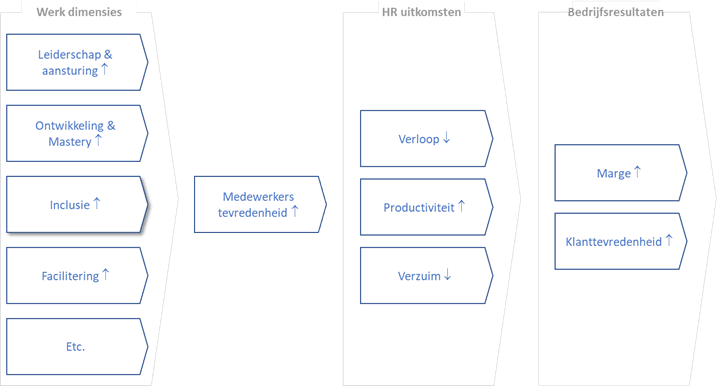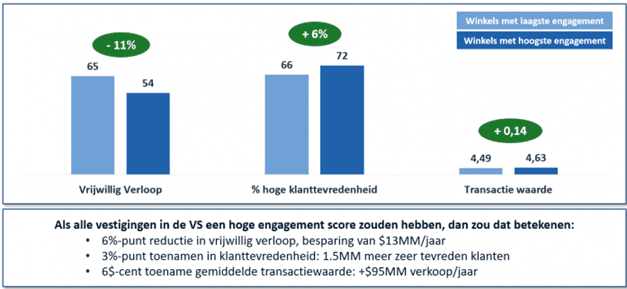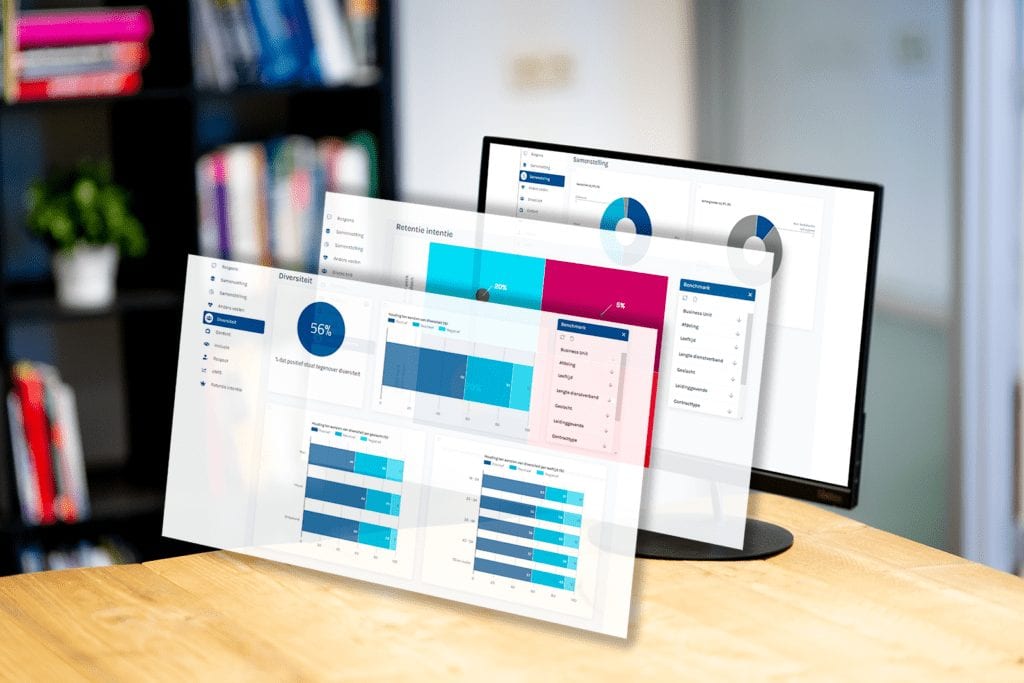Employee surveys offer a structured way to gain insight into the behaviour, thoughts and feelings of potential, current and former employees. The process is also referred to as the Voice of the Employee.
The information can be obtained through both quantitative and qualitative, active as well as passive research.
The most common example of an employee survey is the online survey that focuses on employee satisfaction (active & quantitative). Other examples include focus groups (active & qualitative), analysing internal social media traffic (passive & quantitative) and following people on a certain Employee Journey (passive & qualitative).
Why are Employee Surveys useful?
Employee satisfaction has a direct and indirect impact on the business results, as illustrated in the image below. The best way to gain insight into employee satisfaction and the things that influence employee satisfaction is through employee surveys, which essentially makes them a tool to improve business results. A great by-product is that satisfied employees are happier (at work). You could say that employee surveys allow organizations to kill two birds with one stone!

More information? Feel free to get in touch with us!
Employee Survey process
The process of conducting an Employee Survey consists of eight steps.
- Each study starts with a business problem or challenge that can’t be solved without getting an understanding of the experiences, opinions and/or behaviour of the employees. For example: why is the unwanted turnover among young people so high?
- Once the question has been narrowed down, it’s time to select a suitable method. In other words: which combination of qualitative or quantitative and active or passive research do you want to use?
- When you’ve selected a method, you can decide on further details. In the case of a focus group for instance, you can now choose your target group, group size and the level of structure, duration and location of the sessions.
- When the plan is finalised, you can actually start to listen to the Voice of the Employee.
- After the field work, all collected information needs to be synthesized, and the data analysed. This often involves statistical methods to identify things like employee segments and drivers.
- When all the information is analysed, the findings and recommendations are reported to the ‘problem owner’.
- It’s subsequently up to them to make decisions regarding possible adjustments to existing policies and/or starting certain actions, for example.
- Finally, it’s important to measure the impact and to base future actions on this. Read more about this on the HR Dashboards page.
Our services
AnalitiQs helps organizations carry out employee surveys, optimize their employee surveys and develop their employee survey strategy. Read more about each of these services underneath the headings below.
Carrying out Employee Surveys
AnalitiQs conducts both quantitative and qualitative, active as well as passive research. There are three key points to our approach:
- A study always starts with defining the problem/challenge.
- We aim to gain as many insights as possible, while keeping the burden on the organization as light as possible. That’s why we prefer to focus on things that can actually be changed by actions/policy adjustments, and why we like to use best practices from the field of Marketing.
- Privacy, security and ethics are respected at all times.
Another advantage of working with AnalitiQs is our experience with panels. The AnalitiQs labour market panel for example, allows clients to reach potential employees, and we can facilitate internal employee panels as well.
The framework gives an overview of our areas of expertise.
Would you like to know more about our end products? Click here to watch the dashboard research demo. Or click on this link to see an example of a research report.
Optimizing Employee Surveys
A common complaint about employee surveys is that they take up too much time and don’t provide enough results. When AnalitiQs is hired for an employee survey, we often fulfil the role of project and change manager. As such, we examine the employee survey’s ecosystem (processes, roles, methods, data, technology) and improve it where needed, to help create more value in less time.
Developing an Employee Survey strategy
The days of one extensive employee satisfaction study per year are over. Most organizations have now transitioned to modern Voice of the Employee programmes, sometimes also referred to as Continuous Listening. AnalitiQs can help you decide what the ideal Voice of the Employee programme should look like. We can tell you what the route to the desired situation looks like and ensure that the transition from ‘a’ to ‘b’ takes place in a structured way.
Employee Survey results and end product
The ultimate result of an employee survey is that employees are happier, and the organization performs better, so you’re killing two birds with one stone! The image below illustrates the relation between Engagement and Turnover, Customer Satisfaction and Transaction Value based on a case study by Starbucks.

If you want your employee survey to lead to results, it’s essential that your organization turns the insights into actions. To help with this, AnalitiQs has developed an online, interactive dashboard with benchmark functionalities. It provides insight into the research outcomes and can be accessed by policy makers and action owners at all times. If a client would like to receive a management report, AnalitiQs can provide this too. It will include an overview of the most important insights and recommendations. With this combination of dashboard and report, action owners are optimally equipped to turn insights into actions and results!

I’m really happy with the help and support we received from AnalitiQs. They’re smart and with their expert knowledge, they really understand the story behind the figures. I like the dashboard; it allows you to make data-based decisions and you can make your own comparisons.
Teamlead HR & Talent development
IT branch
Interested? Feel free to contact us!

Gido van Puijenbroek
Detailed Service Overview
HR Analysis
Equal Pay
Gender mobility
Absenteeism
Employee Segmentation
Employee Retention & Attrition
Engagement
Impact Measurement / ROI
Learning & Development
Management Development
Onboarding
Organisational Network
Performance
Process Mining
Productivity
Recruitment
Restructuring / Organizational-Development
Reward
Strategic Workforce Planning
Succession Management
Employee Surveys
Culture
Employee Satisfaction
Job Satisfaction
Inclusion
Onboarding
Employee Turnover
Diversity
Employee Community / Panel
Employee Engagement
Employee Commitment
Employee Journey
Employee Net Promotor Score (eNPS)
Employee Value Proposition (EVP)
Employee Enthusiasm
Labour Market
Labour Market Panel
Labour Market Positioning
Leadership
Manager Feedback
Personal Development
Pulse
Retention
Role Clarity
Sentiment
Strategic Alignment
Team Feedback
Total Reward Optimization
Voice of the Employee (VoE)
Work from home
Work Stress
Work Pressure
Capability Building
HR Analytics Strategy
HR Analytics Product Owner
HR Analytics Outsourcing
HR Academy
HR Dashboards
Absenteeism Dashboard
Integral HR Dashboard
Leadership Dashboard
Learning Dashboard
Recruitment Dashboard
Reward Dashboard
Talent Development Dashboard
